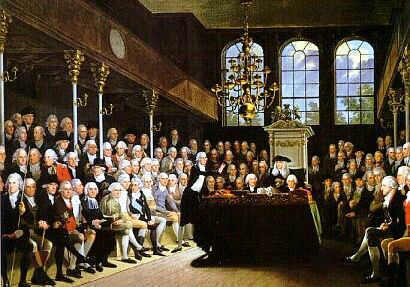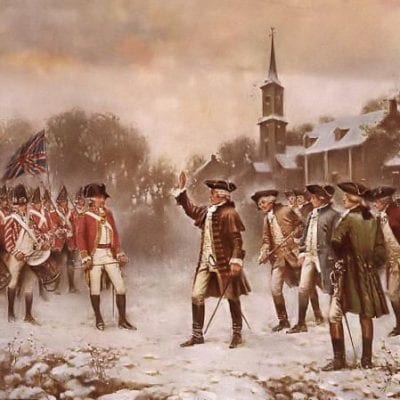On this day in 1774, dissenting British minister Joseph Priestley, author of Observations on Civil Liberty and the Nature and Justice of the War with America, discovers oxygen while serving as a tutor to the sons of American sympathizer William Petty, 2nd Earl of Shelburne, at Bowood House in Wiltshire, England. When he discovered oxygen, he answered age-old questions of why and how things burn. An Englishman by birth, Priestley was deeply involved in politics and religion, as well as science. When his vocal support for the American and French revolutions made remaining in his homeland dangerous, Priestley left England in 1794 and continued his work in America until his death.
In the mid-18th century, the concept of an element was still evolving. Researchers had distinguished no more than two dozen or so elements, depending on who was doing the counting. It wasn’t clear how air fit into that system. Nobody knew what it was, and researchers kept finding that it could be converted into such a variety of forms that they routinely spoke of different “airs.”
The principal method for altering the nature of air, early chemists learned, was to heat or burn some compound in it. The second half of the 1700s witnessed an explosion of interest in such gases. The steam engine was in the process of transforming civilization, and scientists of all types were fascinated with combustion and the role of air in it.
British chemists were especially prolific. In 1754, Joseph Black identified what he called “fixed air” (now known to be carbon dioxide) because it could be returned, or fixed, into the sort of solids from which it was produced. In 1766, a wealthy eccentric named Henry Cavendish produced the highly flammable substance Lavoisier would name hydrogen, from the Greek words for “water maker.”
Finally in 1772, Daniel Rutherford found that when he burned material in a bell jar, then absorbed all the “fixed” air by soaking it up with a substance called potash, a gas remained. Rutherford dubbed it “noxious air” because it asphyxiated mice placed in it. Today, we call it nitrogen.
But none of those revelations alone tells the whole story. The next major discovery would come from a man whose early life gave no indication that he would become one of the greatest experimental chemists in history.
In 1767, Priestley was offered a ministry in Leeds, Englane, located near a brewery. This abundant and convenient source of “fixed air” — what we now know as carbon dioxide — from fermentation sparked his lifetime investigation into the chemistry of gases. He found a way to produce artificially what occurred naturally in beer and champagne: water containing the effervescence of carbon dioxide. The method earned the Royal Society’s coveted Copley Prize and was the precursor of the modern soft-drink industry.
Joseph Priestley was born in Yorkshire, the eldest son of a maker of wool cloth. His mother died after bearing six children in six years. Young Joseph was sent to live with his aunt, Sarah Priestley Keighley, until the age of 19. She often entertained Presbyterian clergy at her home, and Joseph gradually came to prefer their doctrines to the grimmer Calvinism of his father. Before long, he was encouraged to study for the ministry. And study, as it turned out, was something Joseph Priestley did very well.
Aside from what he learned in the local schools, he taught himself Latin, Greek, French, Italian, German and a smattering of Middle Eastern languages, along with mathematics and philosophy. This preparation would have been ideal for study at Oxford or Cambridge, but as a Dissenter (someone who was not a member of the Church of England) Priestley was barred from England’s great universities. So he enrolled at Daventry Academy, a celebrated school for Dissenters, and was exempted from a year of classes because of his achievements.
After graduation, he supported himself, as he would for the rest of his life, by teaching, tutoring and preaching. His first full-time teaching position was at the Dissenting Academy in Warrington. (Although obviously brilliant, original, outspoken and, by one report, of “a gay and airy disposition,” Priestley had an unpleasant voice and a sort of stammer. That he made a living through lectures and sermons is further evidence of his extraordinary nature.)
In 1762, he was ordained and married Mary Wilkinson, the daughter of a prominent iron-works owner. She was, he noted, “of an excellent understanding, much improved by reading, of great fortitude and strength of mind, and of a temper in the highest degree affectionate and generous; feeling strongly for others and little for herself.”
Priestley traveled regularly to London, and became acquainted with numerous men of science and independent thought, including an ingenious American named Benjamin Franklin, who became a lifelong friend. Franklin encouraged Priestley in his research, one result of which was The History and Present State of Electricity. For that work, and his growing reputation as an experimenter, Priestley was made a Fellow of the Royal Society in 1766.
The History book was too tough for a popular audience, and Priestley determined to write a more accessible one. But he could find no one to create the necessary illustrations. So, in typical fashion, he taught himself perspective drawing. Along the way, he made many mistakes, and discovered that India rubber would erase lead pencil lines — a fact he mentioned in the preface.
By the age of 34, Priestley was a well-established and respected member of Britain’s scientific community. He was still paying a price for his religious nonconformity, however. When the explorer Captain James Cook was preparing for his second voyage, Priestley was offered the position of science adviser. But the offer was rescinded under pressure from Anglican authorities who protested his theology, which was evolving into a strongly Unitarian position that denied the doctrine of the trinity.
In retrospect, the Cook affair may have been all for the best. In 1773, the Earl of Shelburne asked Priestley to serve as a sort of intellectual companion, tutor for the earl’s offspring, and librarian for his estate, Bowood House. The position provided access to social and political circles Priestley could never have gained on his own, while leaving ample free time for the research that would earn him a permanent place in scientific history.
He systematically analyzed the properties of different “airs” using the favored apparatus of the day: an inverted container on a raised platform that could capture the gases produced by various experiments below it. The container could also be placed in a pool of water or mercury, effectively sealing it, and a gas tested to see if it would sustain a flame or support life.
In the course of these experiments, Priestley made an enormously important observation. A flame went out when placed in a jar in which a mouse would die due to lack of air. Putting a green plant in the jar and exposing it to sunlight would “refresh” the air, permitting a flame to burn and a mouse to breathe. Perhaps, Priestley wrote, “the injury which is continually done by such a large number of animals is, in part at least, repaired by the vegetable creation.” Thus he observed that plants release oxygen into the air — the process known to us as photosynthesis.
On August 1, 1774, he conducted his most famous experiment. Using a 12-inch-wide glass “burning lens,” he focused sunlight on a lump of reddish mercuric oxide in an inverted glass container placed in a pool of mercury. The gas emitted, he found, was “five or six times as good as common air.” In succeeding tests, it caused a flame to burn intensely and kept a mouse alive about four times as long as a similar quantity of air.
Priestley called his discovery “dephlogisticated air” on the theory that it supported combustion so well because it had no phlogiston in it, and hence could absorb the maximum amount during burning. (The year before, Swedish apothecary Carl Wilhelm Scheele isolated the same gas and observed a similar reaction. Scheele called his material “fire air.” But his findings were not published until 1777.)
Whatever the gas was called, its effects were remarkable. “The feeling of it in my lungs,” Priestley wrote, “was not sensibly different from that of common air, but I fancied that my breast felt peculiarly light and easy for some time afterwards. Who can tell but that in time, this pure air may become a fashionable article in luxury. Hitherto only two mice and myself have had the privilege of breathing it.”
Source: https://www.acs.org/content/acs/en/education/whatischemistry/landmarks/josephpriestleyoxygen.html



